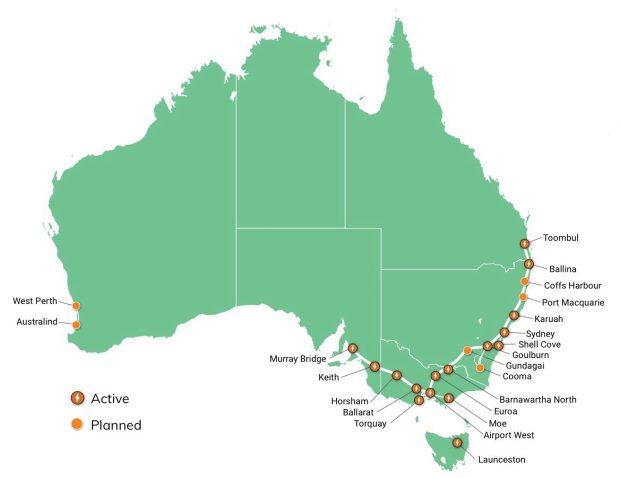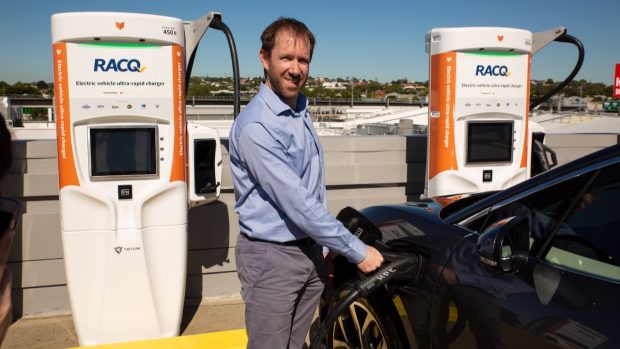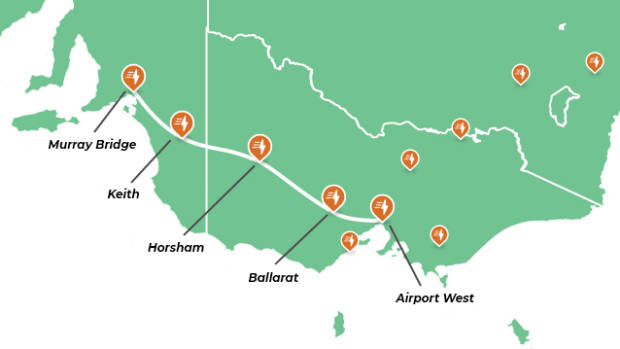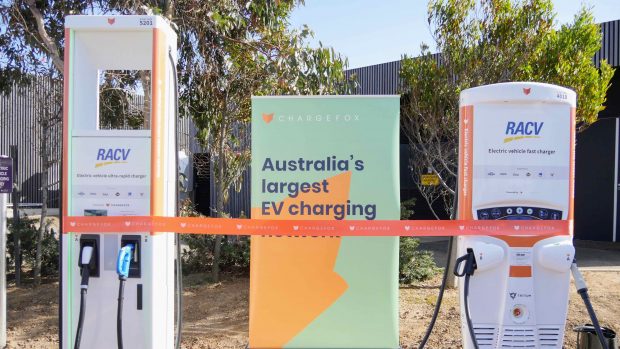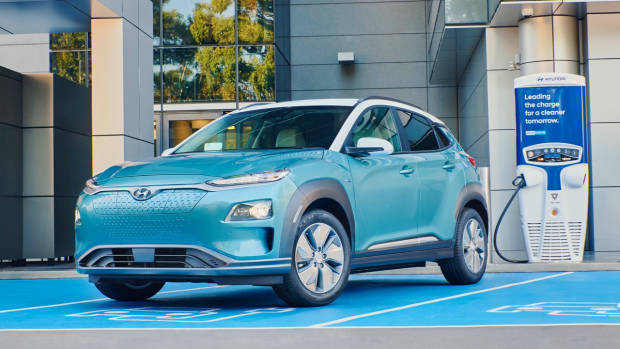-
Car Reviews
- All reviews
- Midsize SUVs
- Small cars
- Utes
- Small SUVs
- Large SUVs
- Large cars
- Sports SUVs
- Sports cars
- Vans
Latest reviews
- Car News
-
Car Comparisons
Latest comparisons
- Chasing Deals
The chief executive officer of EV infrastructure provider Chargefox says his charging network will soon enable Australian EV owners to rapidly travel between Sydney and Melbourne and rocket between Sydney and Brisbane using their purpose-built 350kW fast chargers.
Chargefox boss Marty Andrews was bullish about the future of long-distance EV travel in Australia following Chargefox’s opening of a new rapid-charging station in the western Victorian town of Horsham – filling a 390km black hole between Melbourne and Adelaide and completing the electric ‘superhighway’ between those capital cities.
The five-strong charging network linking Melbourne and Adelaide means that almost all EVs of various capabilities and price points should be able to make the trip, with each charging station not separated by more than 200km.
“It’s only the very smallest city cars that will struggle to make that now, most cars will get there comfortably,” Mr Andrews told Chasing Cars.
Andrews is trying to fill in all major Australian road routes as quickly as he can, with rapid-charging stations already dotted along the 878km Sydney to Melbourne drive and the 911km Sydney to Brisbane route – but with distances between rapid-chargers averaging 218km, there are gaps. Mr Andrews says that new stations will see those ‘holes’ filled by the end of 2020.
“Melbourne to Sydney is getting better and better all the time. We’ve still got a couple of sites that we are trying to get done along the way there, but the combination of the Chargefox network and the NRMA network means that is getting more and more comfortable over time,” Mr Andrews said.
Currently, there is only one comparatively slow 50kW charging station at Gundagai between Australia’s two largest cities, but a new Chargefox station with two 350kW plugs should be available for use at Gundagai within the year
For the Sydney to Brisbane route, two major charging stations are under construction at Coffs Harbour and Port Macquarie which will complete the rapid-charging superhighway once built.
“Our original plan was to have 22 sites, and there are 16 or 17 that have officially opened – so we are on the tail end of that, and that will be completed this year,” Mr Andrews said.
Andrews says he is determined to build a system that is future-proofed – and so every Chargefox station being built is now equipped with ultra-rapid 350kW chargers that far surpass the average charging rates of almost all EVs available.
In fact, the only EV currently capable of charging at 350kW/h is the Porsche Taycan – however even it is software limited to 270kW/h for the time being. The recently updated Tesla Model S Long Range Plus is capable of charging at 250kW/hour. Many other recent EV arrivals, including the Audi e-tron, are only capable of 150kW/hour speeds.
For context, at 350kW, an EV will gain approximately 400km of range in 20 minutes, while a 150kW-capable vehicle would add about 190km of range in the same time.
As border restrictions look to loosen over the holiday season and into 2021, Mr Andrews said he wants his network to be ready for Australians not just travel state to state, but also to explore Australia with ease.
“Everyone who was going to go on their European holiday tour this year will now be thinking ‘well, where can I go?’, and we want them to be able to visit Australia again and go out to visit those regional towns and explore – those are the places that need EV chargers next.”
Mr Andrews said the most pressing need for the next rapid-charging station is within south-western Sydney, but he also then plans to put charge points at popular Victorian holiday destinations such as the Great Ocean Road, the Mornington Peninsula, Falls Creek and Mt Buller.
With unrestricted international travel banned for the foreseeable future, Mr Andrews – whose company receives funding from the federal government-funded Australian Renewable Energy Agency to assist in establishing charging stations – said it was time for authorities to dig deep to help build more charging stations in rural areas.
Andrews says the funding would not only divert more traffic to areas struggling with the financial fallout of the pandemic, but also assist communities who are still struggling to recover from the 2019/2020 bushfire season that killed 33 people and destroyed over 3,500 homes.
“There are opportunities for the government at the federal, state and local level to fund the creation of infrastructure and a new industry – it creates new jobs and promotes domestic tourism into the regions that so despite need it right now,” he said.
While the high entry price point for EVs still remains too high for many Australian families to justify over a petrol equivalent, the market is becoming increasingly competitive and the technology more capable.
And while you will often have to purchase luxury options such as the Mercedes-Benz EQC ($137,900 before on road costs) to use fast charging, many cheaper options such as the Hyundai Kona Electric Highlander ($65,290 before on-roads) can travel 449km, according to the WLTP standard, and use a 50kW/h charger.
The forthcoming MG ZS EV will likely land as Australia’s most affordable electric vehicle in 2021. The Chinese-built electric ZS also uses 50kW charging, and was recently offered in a pre-sale for $46,990 driveaway.
In between the extremes sits the Tesla Model 3 – which, in $66,900 Standard Range Plus form, offers 430km of range and the capability to charge at a quick 170kW/hour. The Model 3 is the best-selling EV in many global markets.
Latest news
About Chasing cars
Chasing Cars reviews are 100% independent.
Because we are powered by Budget Direct Insurance, we don’t receive advertising or sales revenue from car manufacturers.
We’re truly independent – giving you Australia’s best car reviews.
